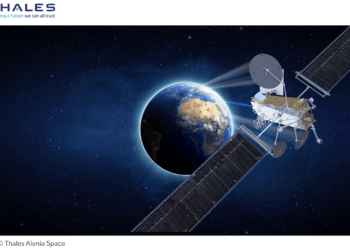The VERTIGO (Very High Throughput Satellite-Ground Optical link) project successfully demonstrated a high-power optical data transmission system at the Thales laboratory in Palaiseau, France.
Thales Alenia Space, Thales, G&H and Leo Space Photonics R&D demonstrated the generation and transmission of optical communication signals carrying data at 25 Gbps in a controlled environment at a record breaking optical power of 97 W opening the way to 100W-class transmissions. This was achieved by splitting a modulated optical signal into two paths, each amplified through an individual state-of-the-art G&H high power amplifier, and then coherently combining the two amplifier outputs. This was an opportunity not only to demonstrate high and very high optical power generation but also to prove the possibility to transmit telecom signals at very high power while maintaining data integrity, a necessary condition for use in free-space optical links over long distances.Following the outdoor trials of free-space optical links in Summer 2022, which notably demonstrated a record transmission at 1 Tbps over an atmospheric optical path of 53 km, the laboratory test campaign performed in Thales facilities concludes the VERTIGO project with a new record.
The partners said VERTIGO has shown that future geostationary communication satellites using optical feeder links are feasible.
Capitalizing on the results of the VERTIGO project, the next step will be to target a full-scale coherent laser link between a geostationary satellite at an altitude around 36.000 km and a ground station.
VERTIGO is a H2020 collaborative project funded by the EU, launched on June 1st 2019 and completed at the beginning of 2023. The project consortium was composed of CREONIC GmbH, ETH Zürich, Fraunhofer HHI, G&H, LEO Space Photonics R&D, ONERA, Thales Alenia Space in France and Switzerland and Thales Research & Technology.












